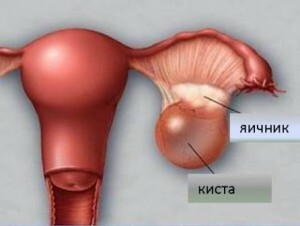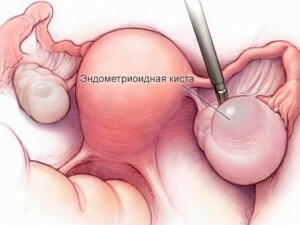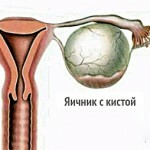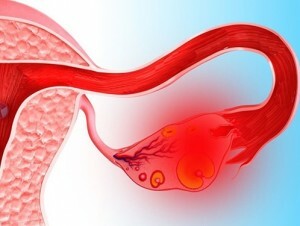Many women, feeling unwell, seek medical attention about cysts on the ovaries that occur at different stages of the cycle. The problem is detected and accidentally during the examination, because it does not give any signs. Why is there such a difference in symptoms? Yes, because these capsules have not one subspecies and level of development. The ovarian cyst code by μB 10 is obtained depending on this. In general, the neoplasms are included in the section on non-inflammatory diseases of paired organs and other appendages of the uterus( N83).
What does it mean"Cyst"
 The appearance on the gonads of cysts is usually associated with the performance of their main function, that is, maturation of the egg. It occurs under the control of hormones, has a clear order. If it is broken, it is possible to form a capsule on the thin pedestal on the ovary, which is filled with fluid, that is, cysts.
The appearance on the gonads of cysts is usually associated with the performance of their main function, that is, maturation of the egg. It occurs under the control of hormones, has a clear order. If it is broken, it is possible to form a capsule on the thin pedestal on the ovary, which is filled with fluid, that is, cysts.
As the volume of content increases, it also grows, which is why other metamorphoses can occur with it. Depending on the causes of the appearance, such as being inside the fluid and other features of the ovarian cyst, the μB 10 is divided into several species. Explicit manifestations of them, if present, are similar:
- Delay of menstruation for 5-30 days;
- Intense pain in critical days, heaviness in the abdominal cavity, nausea. The most noticeable sensations are noted in the region of cyst localization;
- Increased volume of secretions or, on the contrary, markedly decreased.
Follicular
The follicular ovarian cyst has a code in μB 10 No. 83.0.It can arise as a result of a small malfunction in the functions of the reproductive system in a woman of reproductive age. Entering menopause, its appearance is not threatened, as the neoplasm grows from an unexploded follicle. Education is a capsule with clear mucus, saturated with estrogen, and an ovarian sheath. Dimensions of it are from 2.5 to 10 cm

Its development can be promoted by:
- Hidden infections( including venereal infections);
- Adolescent or pre-menopausal age;
- Inflammatory diseases;
- Operations performed on reproductive organs;
- Endocrine Disorders;
- Stress.
Cyst of the yellow body
 Ovarian cyst code mkb No. 83.1 is associated with the appearance of the yellow body. After aging of the germ cell, the body prepares for probable fertilization, for which progesterone is produced in the gland.
Ovarian cyst code mkb No. 83.1 is associated with the appearance of the yellow body. After aging of the germ cell, the body prepares for probable fertilization, for which progesterone is produced in the gland.
The absence of pregnancy should lead to resorption of the yellow body. But different circumstances can prevent this, and then a cyst appears on the organ.
This type of neoplasm is filled with serous fluid, but it forms in another cycle period, in the second stage. Yellow body cyst is usually a single-cell, 6-8 cm in size.
Hemorrhagic cysts
Complicated development of functional cysts provokes not only their expansion, but also the appearance of non-serous fluid in the interior, and blood. There is a process due to the fault of the bursting vessel, the contents of which fell into the neoplasm.
Classification takes into account this possibility. This subspecies of the ovarian cyst is included in the list, depending on what it was in the beginning. If follicular, then this is No. 83.0, formed from a yellow body - No. 83.1.
Other cysts classified as
Not all ovarian cysts are directly connected to the working capacity of organs. Occasionally, the cause of their appearance is not possible, although the effect is exerted by the cycle and by the appearance of malaise over time. Such an ovarian cyst code by μB 10 will have under No. 83.2.This includes the following types of tumors:
- Endometrioid, which appeared due to the proliferation of the tissues of the uterine mucosa into the ovary;
- Dermoid, containing inside the capsule particles of skin, teeth, hair;
- Paraovarian, growing from the epididymis;
- Mucinous, filled with mucus of a similar name, rapidly growing and prone to rebirth.
Neoplasms on the right and left glands of the
Both ovaries have the same structure, because they are paired glands. Therefore, all the possible complexities of the processes occurring in them are analogous. And yet there are differences caused by the nuances of the location of the glands.
For the right ovary, increased blood supply is common, since its artery is a site of the abdominal aorta. Blood pressure there is higher, which predisposes in some cases to the growth of capsules. In this case, the cyst of the right ovary will be given a code of 10 for microbes, depending on its type. Endometrioid capsules are often formed here.

Mkb 10 cyst of the right ovary is evaluated in a variety of cases, such as hemorrhagic, often with a difficult course of the pathology. It more and more quickly acquires a large size, gives a clearer traceable symptomatology with pain, nausea, a feeling of bursting into the small pelvis, problems with defecation and urination. And complications are more often fixed with a cyst on the right organ.
Complication with ovarian cysts
With intensive physical activity, an undetected or left untreated cyst can be damaged. The destruction of its shell leads to the removal of the contents in the abdominal cavity.
The neoplasms themselves can sometimes exist without causing anxiety. But their damage occurs with acute pain, a fit of weakness. And although the break of the ovarian cyst of microbial 10 does not emit, it is a complication that leads to immediate professional intervention.
 We recommend to read an article on the monthly for an ovarian cyst. You will learn about the nature of education and the causes of its appearance, the effect of the cyst on menstruation and cycle, the operation to remove it.
We recommend to read an article on the monthly for an ovarian cyst. You will learn about the nature of education and the causes of its appearance, the effect of the cyst on menstruation and cycle, the operation to remove it.
Ovarian damage
 In contrast to the rupture of cysts, ovarian apoplexy of microbial cells 10 is separated into a special section. This is a sharp violation of the integrity of the tissues of the organ with a splash of blood into the abdominal cavity. It happens under the influence of a sudden strong physical exertion or a change in the balance of hormones.
In contrast to the rupture of cysts, ovarian apoplexy of microbial cells 10 is separated into a special section. This is a sharp violation of the integrity of the tissues of the organ with a splash of blood into the abdominal cavity. It happens under the influence of a sudden strong physical exertion or a change in the balance of hormones.
Ovary apoplexy( code on μB 10 No. 83) occurs:
- Against the background of vascular changes;
- In inflammatory diseases of organs;
- At the time of ovulation or at the stage of resorption of the yellow body.
Because of the peculiarities of the blood supply, the right organ suffers more often.
The ovarian apoplexy system is treated as a noninflammatory disease, however, it gives severe symptoms:
- Severe abdominal pain with recoil. It is found in the middle of the cycle or after a delay. The intensity depends on the volume of vascular damage and the amount of blood splashed out;
- Sharp deterioration of general health with vomiting, weakness, fever;
- In some cases spotting outside of menstruation is recorded.
Problems with the ovaries and in the absence of pain are manifested in menstrual irregularities. These are delays, painful periods, changes in the volume of secretions. Therefore, if you are attentive, you can find them at the beginning of development and get rid without waiting for complications.
